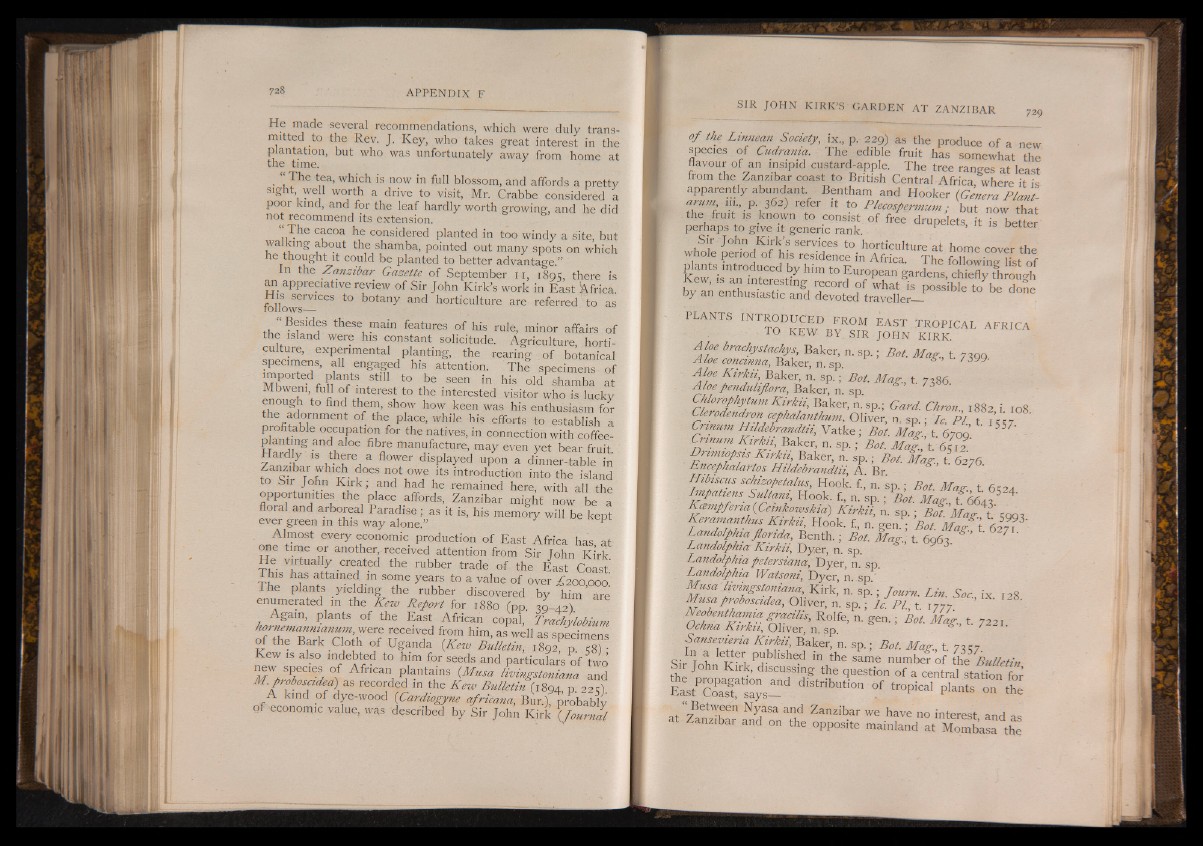
He made several recommendations, which were duly transmitted
to the Rev. J. Key, who takes great interest in the
plantation, but who was unfortunately away from home at
the time.
. , tea, which is now in full blossom, and affords a pretty
sight well worth a drive to visit, Mr. Crabbe considered a
poor kind, and for the leaf hardly worth growing, and he did
not recommend its extension.
The cacoa he considered planted in too windy a site, but
, out the shamba, pointed out many spots on which
he thought it could be planted to better advantage.”
In the Zanzibar Gazette of September u , 1895, there is
an appreciative review of Sir John Kirk’s work in East Africa,
follows—1CGS t0 b° tany and horticulture are referred to as
“ Besides these main features of his rule, minor affairs of
the island were his constant solicitude. Agriculture, horticulture,
experimental planting, the rearing of botanical
specimens, all engaged his attention. The specimens of
imported plants still to be seen in his old shamba at
Mbwem full of interest to the interested visitor who is lucky
to find 5®’ show how keen was his enthusiasm for
the adornment of the place, while his efforts to establish a
profitable occupation for the natives, in connection with coffee-
planting and aloe fibre manufacture, may even yet bear fruit.
7 rd/ IS , ?re, a flower displayed upon a dinner-table in
1 o ^ r l t v ' f ° eS ,lts introduction into the island
to Sir John K irk ; and had he remained here, with all the
opportunities the place affords, Zanzibar might now be a
floral and arboreal Paradise; as it is, his memory will be kept
ever green in this way alone.” P
Almost every economic production of East Africa has at
one time or another, received attention from Sir Tohn Kirk
He virtual y created the rubber trade of the East Coast'
ThlS attamed ,ln so™e years to a value of over ¿200,000.
The plants yielding the rubber discovered by him áre
enumerated in the Kew Report for 1880 (pp. /q- a2)
Again, plants of the East African copal, Trachylobium
hornemanmanum, were received from him, as well as specimens
o f the Bark Cloth of Uganda (Kew Bulletin, 1892, p 58) •
Kew is also indebted to him for seeds and particulars of two
new species of African plantains {Musa livingstoniana and
M.probosaded) as recorded in the Kew Bulletin (1894, p. 22 0
A kind of dye-wood (Cardiogyne africana, Bur.), probably
of economic value, was described by Sir John Kirk (journal
o f the Lmnean Society, ix., p. 229) as the produce of a new
species of Cudrama. The edible fruit has somewhat the
flavour of an insipid custard-apple. The tree ranges at least
from the Zanzibar coast to British Central Africa, where it is
apparently abundant Bentham and Hooker {Genera Plant-
arum in., p 362) refer it to Plecospermum% but now that
the fruit is known to consist of free drupelets, it is better
perhaps to give it generic rank. ’ - r
whole period^fhL?es7 dCencte°in Africa^ T h l ib ™ H
plants introduced by him to
Kew, is an interesting record of what is poss ble to b e done
by an enthusiastic and devoted traveller—
PLANTS P R O D U C E D FROM E AST TROPICAL AFRICA
TO K EW BY. SIR JOHN KIRK.
Aloe brachystachys Baker, n. sp.; Bot. Mag., t. 7390
Aloe concmna, Baker, n. sp.
I B H H H t e n‘ Sp‘ Aloependulifora, Baker, n; . Bspo.L Mag-, t. 7386.
Chlorophytum K irk ii, Baker, n.sp.; Card. Chron., 1882 i 108
Clerodendron cephalanthum, Oliver, n. sp.; Ic. P I t 1337
Crmum Hildebrandtii, V atk e ; Bot. Mag., t. 6709
Cnnum K irk ii, Baker, n. sp.; Bot. Mag., t. 6512.
Dnmiopsis Kirkii, Baker, n. sp.; Bot. Mag t 6276
Encephalartos Hildebrandtii, A. Br.
Hibiscus schizopetalus, Hook. f. n. sp.; Bot Mae- t
Impatiens Sultani, Hook. f„ n. sp .; Bot M a T f t e ^
Kcempferia (Ceinkowskia) Kirkii, n. sp .; Bot Mag t 3993
Keramanthus Kirkii, Hook, f, n. gen.; Bot M a l t 627?
Landolphia florida, Benth.; Bot. Mag., t. 6963. 7
Landolphicr Kivku^ Dyer, n. sp.
Lctndolpkia petersiana, Dyer, n. sp.
Landolphia Watsom, Dyer, n sp
Musalivingstoniana, Kirk,’ n.' sp.'; Journ. Lin. Soc ix 128
Musa proboscidea, Oliver, n. sp.; lc. PL, t. 1777 ’
Neobentlmmia gracilis, Rolfe, n. gen.; Bot. Mag, t 7221
Ochna Kirkn, Oliver, n. sp. * ’ / l '
Sansevieria Kirkii, Baker, n. sp.; Bot. Mag. t. 7237
Sirfoh K eil Pu bllShed in the same number of the Bulletin
Sir John Kirk, discussing the question of a central statfon for
EastPCo2 “ s “ d,strib“ « ° " »f t » P W plants on the
at yB: ( Wr Ny,asa aad Zanzi^ we have no interest and as
Zanzibar and on the opposite mainland at Mombasa the